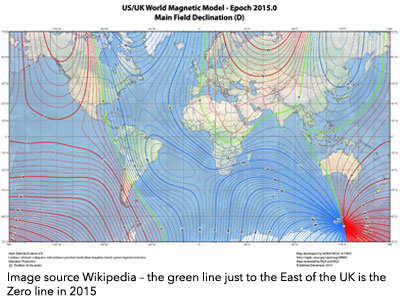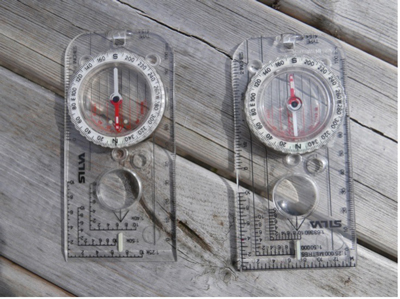February 2022 - Compasses and magnetism
by Nigel Williams
Having a compass and knowing how to use it will have a big impact on your navigation. As technology develops, so does interference with the magnetic needle of a compass. In this blog, Nigel Williams discusses the working principles of the compass and what can affect its magnetism.

Every time we take a "grid bearing" off the map using the grid lines we should currently be adjusting the compass dial to subtract around 0.5º to match it to the ground, changing a "grid bearing" to a "magnetic bearing" that we can follow. This is reversed if one takes a bearing on an object and then brings that back onto the map. However, the compass dial is usually marked in 2 degree increments and almost impossible to adjust for anything less than that.
If it sounds complicated do not worry, in the UK we can forget it for probably the next 25-30 years when it starts to get to around 5 degrees or more, because according the compass manufacturers the devices can be up to 2.5º inaccurate. Like it or not, taking a bearing on the map involves several steps where we may build in small alignment errors of just a degree to two, and that is before we try to walk on it which is likely to add a few more degrees of error. These minor errors don't necessarily compound each other, but there is a level of inaccuracy that we have to accept, and it is unlikely to be relevant for quite a few years for all but the most demanding navigational challenges. Novices certainly do not even need to know about magnetic variation for their use of a compass.
If you put a compass next to a piece of ferrous metal, such as a penknife, the red end of the needle may be drawn towards or repelled by it. This is referred to as causing "magnetic deviation". But as soon as the compass moves a few inches away it settles accurately again. If we have a strong magnet and gently rub it around on a compass capsule it can cause the north and south ends of the needle to swap permanently, reversing everything you do with a compass by 180 degrees. This is serious and can affect any brand of compass and it has caused a few mountain rescue call outs for competent navigators.

Small walkie talkie radios, mountain rescue radios and VHF radios for sea kayakers all have speakers in them, and some cameras may also have speakers all reliant on fairly strong magnets. Just for clarity, these magnets do not require a current. You can switch your phone off and throw the battery away. The magnet is still there functioning the same as your magnetic compass needle.
Some phone cases also have magnet closures in them. More recently outdoor equipment manufacturers have been using magnets in belts, chin straps, drinking tube clips which keep the tube attached to the front of the sac and fingerless gloves with a fold over mitten piece which is attached out of the way to the back of the hand with a magnet. Potentially a worrying thought if you are compass in hand trying to follow a bearing. These are unlikely to cause the needle to change polarity as they are not likely to rub together for an extended period, but they will deviate the needle significantly if the compass is held and used near them.

If you are unlucky enough to find your compass has reversed polarity, simply trying to use it knowing the white end is now pointing north doesn't really work. In fact, the first hint that something might be wrong is that the needle doesn't seem to float and settle normally. This is because when the compass is operating normally the north end of the needle wants to dip to towards the ground. To get the needle to float level in the capsule the white end is about 1mm longer and therefore heavier to counterbalance this dip. If the white heavier end also becomes magnetised as the north end then the dip become significant and the needle ends up scraping the floor of the capsule and fails to settle accurately.
All this starts to question the old adage "always trust your compass". In reality we need to be aware of the potential for interference with the magnetic needle in the modern world. Your compass, and the skills to use it, can have a life preserving impact. Treat it as a valued and delicate scientific instrument.
Browse the full range of navigation aids and compasses
Read more on compass skills: June 2021 Intermediate Navigation & Compass Skills
Read more on compass bearings: June 2021 Intermediate Navigation & Compass Skills
Return to the Navigation Blog
 FREE UK delivery
FREE UK delivery For Christmas delivery information
For Christmas delivery information 







